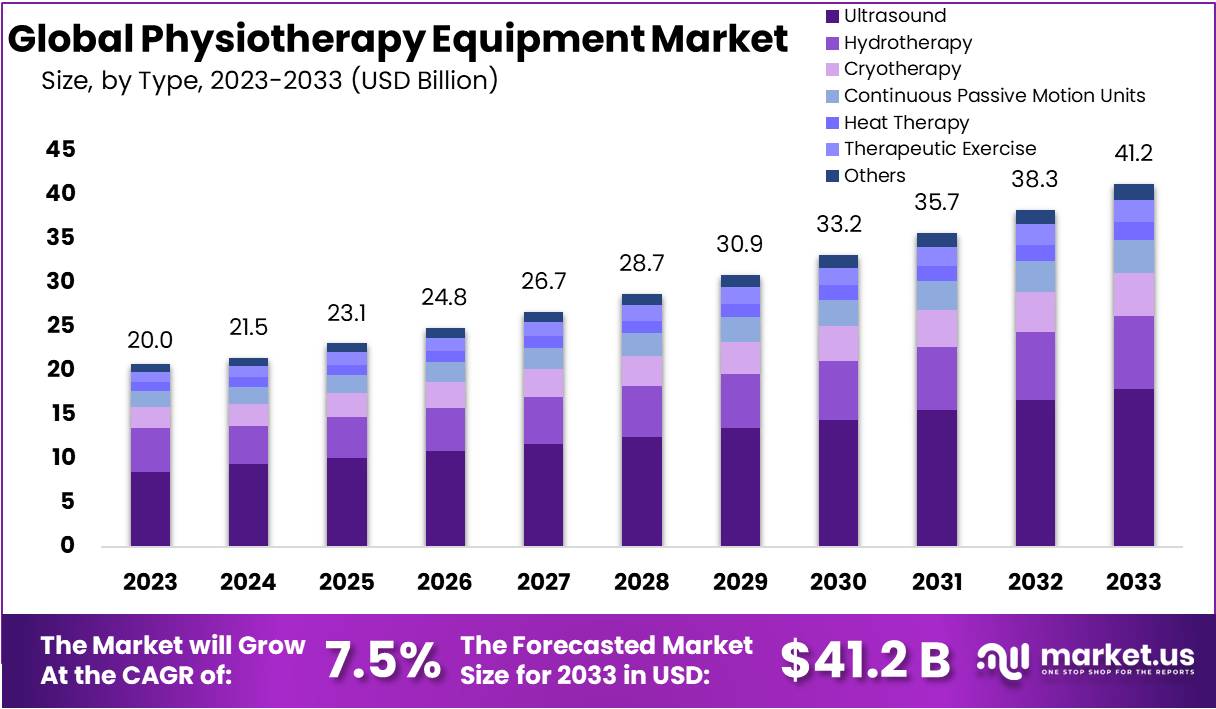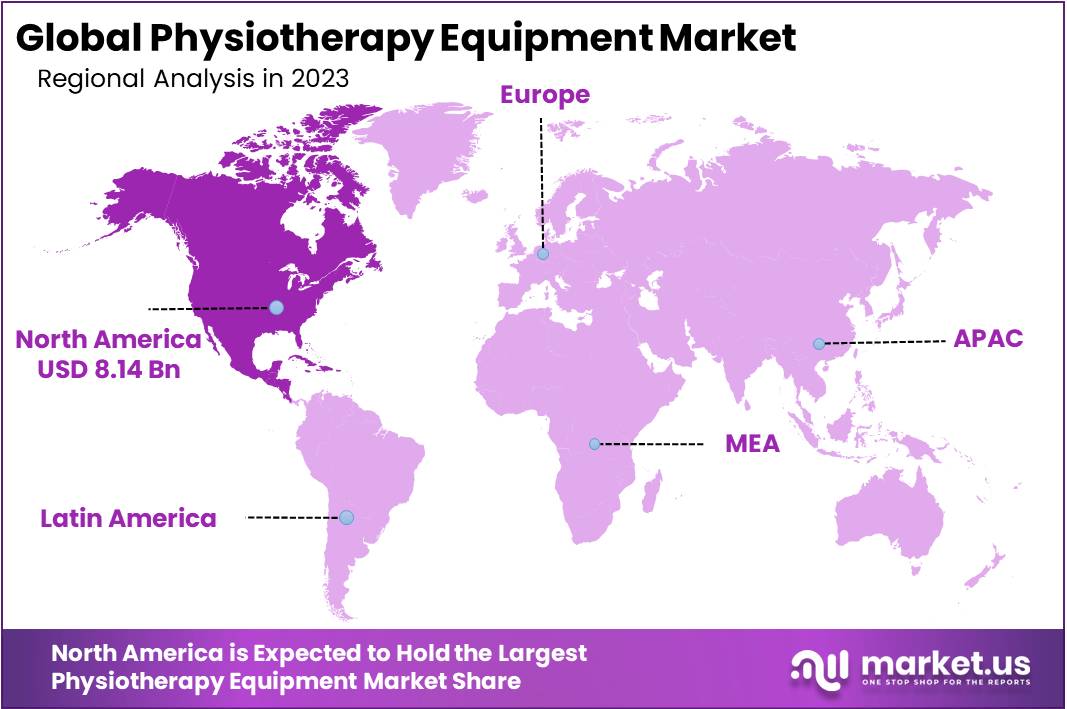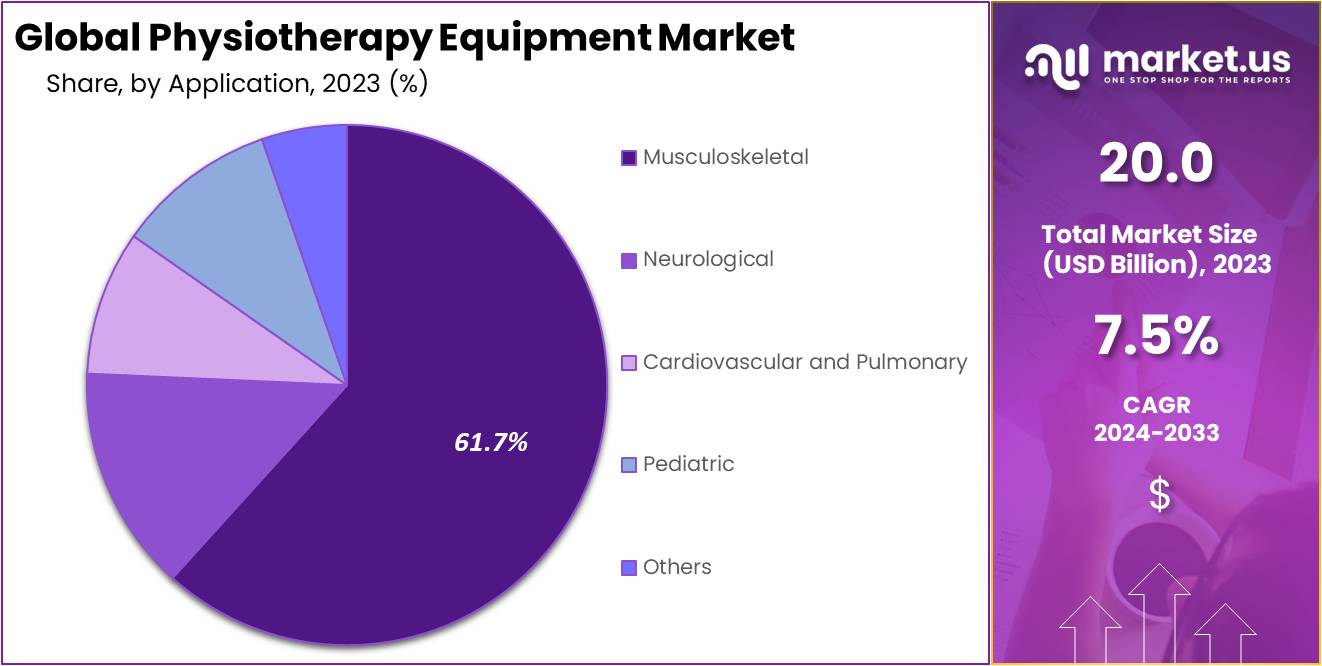New York, Feb. 14, 2024 (GLOBE NEWSWIRE) -- According to Market.us, the global Physiotherapy Equipment market size is forecasted to exceed USD 41.2 Billion by 2033, with a promising CAGR of 7.5% from 2024 to 2033.
The physiotherapy equipment market encompasses a wide range of devices and tools utilized by physiotherapists to aid patients in their recovery journey following injury, surgery, or medical conditions. Its growth is primarily fueled by the increasing prevalence of chronic diseases, musculoskeletal disorders, and an aging population, which require rehabilitation and physical therapy interventions. Moreover, there's a noticeable rise in patient awareness regarding the benefits of physical therapy and rehabilitation, further propelling market expansion.
Within this market, various types of physiotherapy equipment, including therapeutic exercise, electrotherapy, ultrasound, and others, play pivotal roles in enhancing muscle strength, flexibility, pain management, inflammation reduction, healing promotion, and overall physical function improvement for patients undergoing rehabilitation.
Discover key market insights, trends, drivers, and challenges in our sample PDF report: https://market.us/report/physiotherapy-equipment-market/request-sample/

Key Takeaway:
- In terms of type analysis, ultrasound emerged as the leading segment with a revenue share of 43.6%, capturing the largest revenue share due to its therapeutic benefits in promoting healing and reducing inflammation.
- Application-wise, the musculoskeletal segment dominated with a market share of 61.7%, highlighting the importance of physiotherapy in managing conditions affecting muscles, bones, and joints.
- Demographically, the non-geriatric population contributed significantly to the market and secured market share of 56.1%.
- Regarding end-users, hospitals and clinics emerged as the primary segment, with a market share of 45.0%, showcasing their pivotal role in providing rehabilitation services to patients with diverse ailments.
- Region wise, North America remained the highest contributing segment to the market with a market share of 40.7%.
Factors Affecting the Growth of the Physiotherapy Equipment Market:
- The physiotherapy equipment market is driven by the growing prevalence of chronic diseases and musculoskeletal disorders, propelled by factors like aging populations and the preference for non-invasive treatment options. Technological advancements, including robotic-assisted rehabilitation devices and wearable sensors, further enhance market growth potential.
- Conversely, challenges such as the high cost of equipment, a shortage of skilled professionals, and regulatory obstacles impede market expansion, particularly in developing nations.
- Despite these constraints, increasing awareness of the benefits of physiotherapy and the rising demand for personalized treatment options present significant growth opportunities.
- Wearable technology and telehealth solutions are emerging trends in physiotherapy, facilitating remote monitoring and personalized care. Collaborative care approaches among healthcare providers contribute to comprehensive treatment strategies, driving innovation and market evolution.
- Manufacturers investing in R&D and fostering partnerships with healthcare providers stand to capitalize on the dynamic trends shaping the physiotherapy equipment market.
Top Trends in the Global Physiotherapy Equipment Market:
- The latest trends in the physiotherapy market underscore a growing emphasis on wearable technology and personalized treatment approaches. Virtual and augmented realities are increasingly integrated into physiotherapy sessions to enhance patient motivation and engagement by creating immersive and enjoyable therapy experiences. Wearable sensors and devices are gaining popularity as they provide real-time feedback on patient progress and enable remote monitoring, empowering patients to take a more active role in their rehabilitation process, even from the comfort of their homes.
- Moreover, the rising adoption of telehealth in physiotherapy reflects a growing demand for convenient treatment options. Telehealth enables remote consultations and monitoring, offering patients greater flexibility and accessibility to physiotherapy services. Collaborative care is also on the rise, with healthcare providers from various disciplines working together to deliver comprehensive treatment plans tailored to individual patient needs. This collaborative approach may involve physiotherapists collaborating with occupational therapists and orthopedic surgeons to ensure a holistic care approach.
- Overall, the physiotherapy market is evolving rapidly, driven by advancements in technology and a shift towards personalized care models. Manufacturers who can effectively incorporate these trends into their products and services stand to gain a competitive edge in meeting the changing demands of patients and healthcare professionals alike.
Market Growth:
The physiotherapy equipment market is experiencing robust growth globally, driven by several key factors. Firstly, the increasing prevalence of musculoskeletal disorders, chronic diseases, and sports-related injuries is contributing to the growing demand for physiotherapy equipment. As populations age and lifestyles become more sedentary, the incidence of such conditions is on the rise, necessitating rehabilitation and therapy services provided by physiotherapy equipment.
Furthermore, technological advancements in the field of physiotherapy equipment, including the development of robotic-assisted rehabilitation devices, virtual reality tools, and wearable sensors, are enhancing treatment outcomes and patient experiences. These innovations enable more personalized and effective therapy sessions, leading to higher patient satisfaction and better rehabilitation results.
Moreover, the expanding healthcare infrastructure, rising healthcare expenditure, and increasing awareness about the benefits of physiotherapy among both patients and healthcare providers are driving market growth. Additionally, the trend towards home healthcare services and telemedicine is opening up new avenues for the adoption of physiotherapy equipment, especially among patients seeking convenient and accessible treatment options outside traditional clinical settings. Overall, these factors collectively contribute to the positive trajectory of the physiotherapy equipment market.
Macroeconomic Factors:
Several macroeconomic factors significantly impact the physiotherapy equipment market. Firstly, economic indicators such as GDP growth and healthcare expenditure directly influence market performance. Higher GDP often correlates with increased healthcare spending, fostering innovation and adoption of advanced physiotherapy equipment. Regulatory policies and healthcare reforms also play a pivotal role, affecting product approvals and market accessibility. Demographic trends, including aging populations and changing disease patterns, shape market dynamics, driving demand for physiotherapy equipment.
Trade policies and global economic conditions can affect the availability of raw materials and impact manufacturing costs, consequently influencing market competitiveness. Additionally, currency exchange rates and inflation rates can impact pricing strategies and overall market dynamics. Overall, macroeconomic variables are integral to the physiotherapy equipment market, guiding investment decisions, shaping regulatory environments, and influencing consumer behavior. Monitoring these factors is crucial for stakeholders to navigate market fluctuations and capitalize on emerging opportunities while mitigating potential risks.
Regional Analysis:
North America is poised to maintain its dominance in the global physiotherapy equipment market, primarily due to its well-established healthcare infrastructure and substantial healthcare expenditure, particularly in countries such as the United States and Canada. The region claimed a market share of 40.7%. The region benefits from advanced medical facilities and a strong emphasis on healthcare innovation, contributing to the demand for cutting-edge physiotherapy equipment. Additionally, the increasing prevalence of chronic diseases and sports-related injuries in North America further fuels the requirement for physiotherapy equipment, as patients seek effective rehabilitation and recovery solutions.
Meanwhile, the Asia Pacific region is anticipated to witness the fastest growth in the physiotherapy equipment market during the projected period. Factors driving this growth include rising healthcare investments, expanding access to healthcare services, and increasing awareness about the benefits of physiotherapy across countries in the region. Moreover, the growing incidence of chronic conditions and sports injuries in Asia Pacific countries underscores the escalating demand for physiotherapy equipment to cater to the healthcare needs of the population.
Discover tailored insights for your business strategy https://market.us/report/physiotherapy-equipment-market/#inquiry

Scope of the Report
| Report Attributes | Details |
| Market Value (2023) | USD 20.0 Billion |
| Forecast Revenue 2033 | USD 41.2 Billion |
| CAGR (2024 to 2033) | 7.5% |
| North America Revenue Share | 40.7% |
| Base Year | 2023 |
| Historic Period | 2018 to 2022 |
| Forecast Year | 2024 to 2033 |
Market Drivers:
The physiotherapy equipment market is experiencing robust growth driven by several key factors. Firstly, the increasing prevalence of chronic diseases and musculoskeletal disorders globally, such as diabetes and arthritis, necessitates the use of physiotherapy for rehabilitation. Additionally, the aging population is contributing to rising demand for physiotherapy services and equipment, as elderly individuals are more susceptible to injuries and mobility issues.
Moreover, the preference for non-invasive treatment options like physiotherapy over surgery is further propelling market growth. Furthermore, technological advancements in physiotherapy equipment, including electrotherapy and ultrasound, are enhancing treatment efficacy and driving adoption. The emergence of home-based physiotherapy solutions facilitated by telemedicine is also expanding the market's reach, catering to the growing demand for convenient and accessible rehabilitation options.
Market Restraints:
The physiotherapy equipment market faces several restraining factors that hinder its growth potential. Primarily, the high cost of physiotherapy devices limits their adoption, particularly in developing countries with constrained healthcare budgets and limited patient resources. Moreover, the scarcity of skilled physiotherapists and healthcare providers in certain regions impedes the effective utilization of physiotherapy equipment, as patients may lack access to proficient professionals. Regulatory hurdles, including the requirement for approvals before commercial sale, further delay market entry and restrict growth opportunities.
Additionally, alternative treatment methods such as medications and surgeries pose competition to physiotherapy, as some patients may prefer these options, thereby limiting market expansion. These factors collectively challenge the widespread adoption and accessibility of physiotherapy equipment, constraining its potential impact on healthcare outcomes and patient rehabilitation.
Market Opportunities:
The growth opportunities in the physiotherapy equipment market are driven by technological advancements and the increasing prevalence of chronic diseases. Manufacturers focusing on research and development of advanced technologies such as robotic-assisted rehabilitation devices, virtual reality, and wearable sensors stand to gain a competitive edge. These innovations not only enhance treatment outcomes but also improve patient comfort, meeting the evolving demands of healthcare.
Furthermore, the rising incidence of chronic diseases like arthritis, diabetes, and cardiovascular conditions fuels the demand for physiotherapy equipment designed to effectively manage these ailments. Manufacturers that develop equipment tailored to address the specific needs of patients with chronic diseases are poised to capitalize on this growing market demand. Additionally, there is a growing awareness among both consumers and healthcare providers about the benefits of physiotherapy, further driving market growth.
Unlock instant access to our premium report https://market.us/purchase-report/?report_id=35191
Report Segmentation of the Physiotherapy Equipment Market:
Type Insight
The ultrasound segment emerged as the leading revenue generator in the physiotherapy equipment market in 2022. Among the various types of equipment categorized, ultrasound accounted for the largest share, constituting 43.6% of the market during the forecast period. Ultrasound equipment is utilized in physiotherapy for therapeutic purposes, employing high-frequency sound waves to penetrate the body's tissues and induce vibrations in cells. These vibrations play a role in promoting healing processes and reducing pain and inflammation levels. Typically, during ultrasound therapy sessions, physiotherapists apply a gel to the skin over the targeted area to facilitate the transmission of sound waves into the body.
Application Insight
In the physiotherapy equipment market, the musculoskeletal segment holds a significant share within the application segment. Accounting for 61.7% of the market, it stands out as the dominant area of focus. Musculoskeletal physiotherapy involves the assessment and treatment of conditions affecting the muscles, bones, and joints of the body. This specialized field of physiotherapy requires in-depth knowledge of anatomy, biomechanics, and injury management to effectively address musculoskeletal issues. Given the prevalence of musculoskeletal conditions and the importance of their management, musculoskeletal physiotherapy plays a crucial role in promoting recovery and improving the overall well-being of individuals.

Demographics Insight
In the physiotherapy equipment market, the non-geriatric population segment holds a significant share within the demographics analysis. Accounting for 56.1% of the market, it stands out as the dominant group in terms of revenue share during the forecasted period. The non-geriatric population encompasses individuals younger than 65 years who may experience various health conditions requiring physiotherapy intervention. This demographic includes athletes, children, and young adults with neurological, cardiovascular, pulmonary, or musculoskeletal issues, as well as those recovering from injuries or managing developmental disorders.
As awareness of the benefits of physiotherapy expands across different age groups and health conditions, the demand for physiotherapy equipment among the non-geriatric population is expected to remain robust, driving market growth in this segment.
End-User Insight
In the physiotherapy equipment market, the hospitals & clinics segment stands out as a significant player within the end-user analysis, commanding a market share of 45.0%. This segment dominates the market due to its widespread utilization of physiotherapy equipment for rehabilitation purposes across various medical conditions. Hospitals and clinics provide both inpatient and outpatient physiotherapy services, often integrating them with other medical treatments to enhance patient recovery and wellness.
Physiotherapy equipment plays a crucial role in facilitating effective rehabilitation programs within hospital and clinic settings, catering to the diverse needs of patients recovering from injuries, surgeries, chronic conditions, and musculoskeletal disorders. As hospitals and clinics continue to prioritize comprehensive patient care, the demand for physiotherapy equipment in these settings is expected to remain robust, driving sustained growth in this segment of the market.
Tap into Market Opportunities and Stay Ahead of Competitors - Get Your Sample Report Now
Recent Development of the Physiotherapy Equipment Market:
- In May 2023, SynPhNe, headquartered in Singapore, has forged a partnership with Indegene, a life sciences commercialization firm, to introduce its Synergistic Physio-Neuro Platform into the market. The collaboration aims to launch a pioneering connected wearable solution designed by SynPhNe, heralded as the first-of-its-kind device capable of simultaneously training the brain and muscles within a single system. By combining expertise in neuroscience and wearable technology, SynPhNe and Indegene seek to revolutionize rehabilitation practices and improve outcomes for individuals seeking to regain mobility and function following neurological injuries or conditions.
- In November 2023, Salona Global, soon to be rebranded as Evome Medical Technologies, unveils its latest innovation, the Biodex SpaceTek Knee Device, aimed at catering to patients undergoing knee replacements and those with knee injuries. The cutting-edge portable medical device will be distributed solely through the company's subsidiary, Biodex Medical Systems.
Market Segmentation:
Based on Type
- Hydrotherapy
- Cryotherapy
- Continuous Passive Motion Units
- Ultrasound
- Heat Therapy
- Therapeutic Exercise
- Other Types
Based on Application
- Musculoskeletal
- Neurological
- Cardiovascular and Pulmonary
- Pediatric
- Other Applications
Based on Demographics
- Non-geriatric Population
- Geriatric Population
Based on End-User
- Hospitals & Clinics
- Physiotherapy Centers
- Rehabilitation Centers
- Other End-Users
By Geography
- North America
- US
- Canada
- Europe
- Germany
- France
- The UK
- Spain
- Italy
- Russia
- Netherland
- Rest of Europe
- Asia Pacific
- China
- Japan
- South Korea
- India
- New Zealand
- Singapore
- Thailand
- Vietnam
- Rest of APAC
- Latin America
- Brazil
- Mexico
- Rest of Latin America
- Middle East & Africa
- South Africa
- Saudi Arabia
- UAE
- Rest of MEA
Competitive Landscape:
The physiotherapy equipment market is characterized by intense competition among a select few established players who closely monitor market dynamics and strive for innovation to maintain their competitive edge. Technological advancements play a pivotal role in driving market growth, as manufacturers continuously enhance their equipment to offer improved therapeutic outcomes and patient comfort. The increasing incidence of musculoskeletal disorders, coupled with a rising geriatric population globally, further propels the demand for physiotherapy equipment, as these demographic segments often require rehabilitation and therapy services to maintain mobility and functionality.
Additionally, rising healthcare spending across the globe, driven by increasing healthcare awareness and government initiatives, contributes to the expansion of the physiotherapy equipment market by facilitating greater access to advanced therapeutic solutions for patients. Partnerships and collaborations between manufacturers and healthcare providers present significant opportunities in the physiotherapy equipment market. By collaborating, these entities can leverage their respective expertise to develop innovative products and services that align with patient needs and preferences. As the demand for physiotherapy equipment continues to rise, strategic partnerships can facilitate the development and delivery of cutting-edge solutions, ultimately benefiting patients and healthcare providers alike.
Market Key Players:
- BTL Aesthetic
- EMS Physio Ltd.
- Dynatronics Corporation
- RICHMAR
- Performance Health
- Storz Medical AG
- Zimmer MedizinSysteme GmbH
- ITO Co. Ltd.
- Enraf-Nonius B.V.
- Whitehall Manufacturing
- Other Key Players
Explore More Life Science Market Research Reports
- Women's Health Rehabilitation Products Market Size Is Expected To Be Worth Around USD 7.7 Bn By 2032 From USD 4.5 Bn In 2022.
- Pediatric Orthopedic Implant Market size is expected to be worth around USD 7.1 Billion by 2033 from USD 3.5 Billion in 2023
- Intraoperative Neurophysiological Monitoring Market size is expected to be worth around USD 5.1 Billion by 2033 from USD 3.2 Billion in 2023
- Pain Management Devices Market Size Was To Reach USD 4.4 Billion In 2022 & is projected to reach revised size of USD 9.4 Billion By 2032
- Global Orthopedic Implants Market size was worth USD 48 Billion, and it will grow by USD 78 Billion by 2033
- Orphan drugs market is projected to reach a valuation of USD 477 Bn by 2032 at a CAGR of 10.5%, from USD 168 Bn in 2022.
- Global Liver Cancer Drugs Market size is expected to be worth around USD 2,332 Mn by 2032 from USD 980 Mn in 2022, growing at a CAGR of 9.3%
- Global Peptide Therapeutics Market size is expected to be worth around USD 101.7 Billion by 2033 from USD 42.5 Billion in 2023
- Remote Patient Monitoring Software and Services Market Size Is Expected To Be Worth Around USD 78.4 Bn By 2032 From USD 6.7 Bn In 2022
- Cosmetic Surgery Market size is expected to be worth around USD 186.5 Billion by 2033 from USD 82.5 Billion in 2023
About Us:
Market.US (Powered by Prudour Pvt Ltd) specializes in in-depth market research and analysis and has been proving its mettle as a consulting and customized market research company, apart from being a much sought-after syndicated market research report-providing firm. Market.US provides customization to suit any specific or unique requirement and tailor-makes reports as per request. We go beyond boundaries to take analytics, analysis, study, and outlook to newer heights and broader horizons.
Follow Us on LinkedIn
Our Blog:
